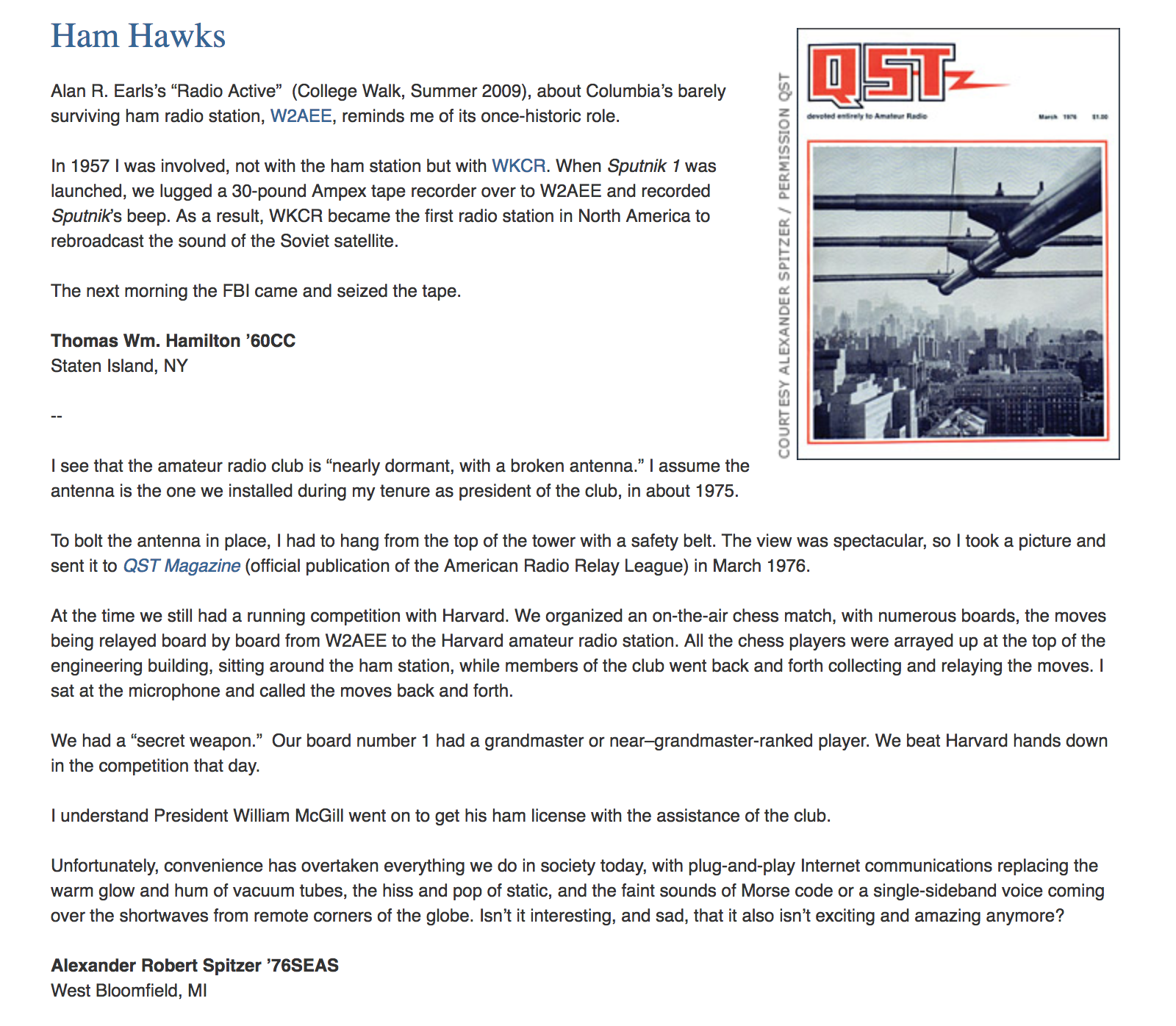History of the CU Amateur Radio Club
The amateur radio hobby which involves two-way communication between amateur radio operators (hams) dates back to the beginnings of radio at the turn of the 20th century. The Columbia University Amateur Radio Club, previously known as the CU Radio Club and the Wireless Telegraph Club of Columbia University came into existence in the early 1900's and has existed continuously ever since -- sometimes dormant and other times quite active.
Editor's Note: As web site technologies evolve, this is the third or fourth re-hosting of this history document. As such there are likely some errors, especially with bad and dead links that still need to be fixed. Please contact us (see the page footer) if you notice errors or have contributions to the club's history.
The Early Days: 1906-1929
Very few good records have been found for this period. Most information is based on second-hand accounts. The Columbia University Experimental Wireless Station was said to have been founded around 1906, in the basement of Chandler Hall or possibly Havemeyer Hall, the adjacent building.
In 1963, the founding date was claimed to have been in 1907 in Pulse, the (now defunct) School of Engineering and Applies Sciences student newspaper:
...The first records of an amateur radio station at Columbia indicate that, in 1907, there was a spark-gap transmitter located In the basement of Chandler hall. Later the club moved to the old engineering building, where it remained until its recent move to SWM [Seeley W. Mudd Hall -Ed], There was a hiatus of approximately one year in the club's operation while the move to SWM was being undertaken, At present, the club has twenty-five members and it is expected that the number will increase since the club is operating again.
A contemporaneous account documenting a founding date of November 23, 1908 (or earlier) was found by Gintautas Gaidamavicius, LY2YR, in this article in the November 24, 1908 edition of the New York Sun which describes an aerial erected between the smokestacks of Havemeyer and University Halls and a quaint competition for domination of the sky between the radio and aeronautics afficianados.
The new organization is the "Wireless Telegraph Club of Columbia University," capital stock subscribed and fully paid by the students of Columbia. The wireless people burst out over night and took the airship navigators by surprise.
"What in blazes is that?" demanded Grover Cleveland Loening, the father of the Aero Club, as he rounded the corner of the library yesterday morning and saw outlined against the foggy sky between Havemeyer and University Halls the double wires that the wireless club was stringing up....
... It is not the purpose of the Wireless Club to pry into other people's affairs, according to E. J. Simon, '09 and A. B. Cole, '11, the originators of the club. Of course, they say, if they happen to catch a message from Mrs. Jones to Mr. Jones telling him to be sure and look after the poodle dog while she is in Europe, they will decipher it....
Prof. Michael Pupin is very much interested in the new club and so is Prof. Crocker, in whose laboratory the receiving and transmitting apparatus is to be installed. Both said yesterday that the scope of the electrical engineering department in the university would have to be enlarged shortly to admit of a course in wireless telegraphy, which, according to them, is quite as important as instruction in the construction and use of airships, for which some of the other professors on campus are agitating.
Further evidence of the Club's early existence was found in Exchanges column of the student newspaper of the University of Pennsylvania, known as The Pennsylvanian at the time.
All crew news at Columbia University is sent from the boat house to the college by wireless telegraph, which has been installed by members of the Wireless Club.
– The Pennsylvanian, April 29, 1909
At the time, the Boathouse was located at the foot of West 115th Street, on the Hudson River.
Not only is there a Yankees - Red Sox rivalry, but those guys on the Charles like to lay claim to having the first college ham radio station when we know that our Alma Mater on the Hudson Shore holds that title. The MIT Radio Society, W1MX has boldly claimed since 1958 that they were founded April 30, 1909 which makes them "America's Oldest College Amateur Station." (QST July 1958, p. 67). This claim has continued to be perpetuated for several decades and was recently reinfored by a 2009 article (QST April 2009, p. 57-58 ). Not so! And disputed more than once, now with two letters to the editor of QST 53 years apart:
Strays
Last July the MIT radio club laid claim to being the oldest in the country. We have heard from K2LWQ, president of the Columbia University Amateur Radio Club (W2AEE), that he has documentary proof that the Columbia University Club was in existence in 1908, and that there is some evidence that it may have been formed in 1906.
– QST Dec. 1958. p. 202 (reprinted with permission)
K2LWQ is currently a vanity call. Presumably the 1958 holder of this callsign is a Silent Key (SK).
The Lion Roars
Are bragging rights for "America's Oldest College Amateur Station" up for grabs? Perhaps the MIT Radio Society, W1MX, should reconsider their claim ["'Rah for Technology: America's Oldest College Amateur Radio Club Turns 100," Apr 2009, pages 57-58], given the predecessor of their modern club was established in 1909; the predecessor of Columbia University's Amateur Radio Club, W2AEE, was founded in November 1908. Gintautas Gaidamavicius, LY2YR, recently found an article in the November 24, 1908 issue of the New York Sun entitled "Wireless Club at Columbia: Disputes with the Aero Club the Monopoly of Morningside Air...."
– Alan Crosswell, N2YGK, Station Manager, Columbia University Amateur Radio Club, W2AEE – QST Apr. 2011. p. 24
Apparently the Harvard Wireless Club, W1AF, also makes claims to be first:
Radio Active
...Enthusiasts can be found on quite a few campuses nationally (Columbia has an FCC charter for station W2AEE), and some of them take their hobby very seriously. This year, for instance, the Harvard Wireless Club is preparing to celebrate its centennial for what it claims is the nation's oldest collegiate amateur radio society – but not without a nervous glance over the shoulder at some other contenders for the title.
While Harvardians had long assumed the veritas of their claim for first-place status, this year MIT's amateurs at W1MX have surfaced a nearly coincident claim, the validity of which may rely on semantics, or else the faith one puts in various faded logbooks and oral traditions. And as if that weren't enough to ebb the Crimson tide, the Harvard hams also have discovered another claim, as yet poorly documented, for a possible first at Columbia....
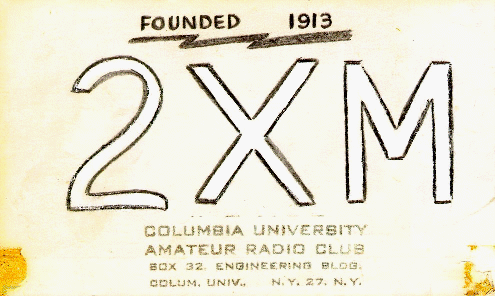
The station became 2XM in 1913 (per the Radio Act of 1912). This is documented in the July 1, 1914 edition of Radio Stations of the United States which lists 2XM as licensed to Columbia University on 600, 1845, 2220 and 2630 meters with control operator John H. Morecroft (Columbia Electrical Engineering faculty and future author of The Principles of Radio Communication in 1921).
The license is categorized as a special class of station:
...such as experiment stations for the development of radio communications, technical and training school stations, and special amateur stations will be alloted by the Bureau of Navigation.
The call will consist of three items – the number of the radio district, followed by two letters of the alphabet. The first letter will be: X, for experiment stations; Y, technical and training schools; Z, special amateur stations....
– p. 8 Radio Stations of the United States, US Department of Commerce. June 1914.
The same document further specifies that amateur station calls are precluded from starting with the letters X,Y, or Z (ibid p.7).
2XM is not listed in the July 1913 edition so it is reasonable to assume that some time in late 1913 the 2XM call sign was issued to Columbia, with Professor Morecroft as the responsible individual -- what is today called the trustee by the FCC.
An article in June 1927 QST (p. 24ff) entitled "5-Meter Work at 2XM With Crystal Control" by A.H. Turner, 3AUX, describes work done 10 miles from Schenectady, NY. This would seem to contradict 2XM being in New York City, as it was listed in 1914. At the time, call signs may have been issued only annually, so it's possible that, fourteen years later, Columbia no longer held 2XM.
References
In addition to the links above, see How to Find Old Amateur Radio Call Signs for excellent guidance on researching historic call signs as well as United States Early Radio History.
A 1914 article in The Sun, originally found in the Columbiana files, describes a wireless demonstration performed by the same faculty member, John Morecroft, in Prof. Pupin's lab:
X IMP BOTHERS WIRELESS.
"Static" Cuts Columbia's Communication With Ireland.
That indefinable imp of the perverse known as "static" or X prevented the operators of Columbia University's new wireless plant from passing the time with San Francisco, exchanging greetings with Ireland and asking Paris about the weather, for the edification of the students and their friends last night.
Ireland was all right in the trials earlier and San Francisco was only in the next room so to speak, but when night came and Prof. J. H. Morecrost (sic), Prof. Pupin's assistant, started things, static closed down and the best they could get was Glace Bay, Washington, Pensacola and a few nearby points.
There were 200 at the lecture last night. Among them were the Naval Academy graduates who are taking a post-graduate course at Columbia. As the receivers were fitted with amplifiers every one could hear the messages come in and most of them could read them.
Wireless telegraphy is young yet, Prof. Morecrost (sic) said. Everybody thinks it wonderful that they got Neuheim, Germany, from Pemberton, N.J., the other day. In a couple of years that will be nothing. They wll get any place on this planet. – The Sun. 1/30/1914.
During World War I, Congress shut down Amateur Radio, resuming the service on October 1, 1919. Shortly thereafter, in November 1920 QST in Calls Heard on page 55, station 2PP, Newark, reports hearing 2XM. Since 2XM was an experimental, rather than Amateur license, it is not clear if the station was shut down during the war.
Around 1924, the station moved from the basement of Havemeyer (Chandler?) to the Engineering (now Mathematics) (a/k/a Armstrong) Attic.
By 1925, 2XM has been reassigned as a special land station in Glenville, NY (upstate Schenectady County) and 2FK has been issued to "Columbia University Radio Club, H.S. Knowles, operator."

H.S. Knowles, the president of the club at the time, was cited in Spec several times:
Radio Club Gathers Tonight
An organization meeting of the recently inaugurated Radio Club will be held at 7:30 o'clock this evening in Earl Hall. President Knowles said yesterday that there will also be a discussion of the apparatus to be used in the set that is being installed in Engineering after the regular business is taken care of.
-- Columbia Daily Spectator, Volume XLVII, Number 91, 7 February 1924

Will Talk to Radio Fans On Uses of Vacuum Tube
Hugh S. Knowles '26, president of the Columbia University Radio Club, will deliver the fourth of the club's weekly talks at 10 o'clock today in 307 Hamilton. The subject will be "The Vacuum Tube; Its Principle and Operation," and all those on the Campus who are interested in radio are invited to attend. As has been the policy of the organization in its three previous talks, the lecture will be in a popular vein so that the average radio listener-in will more easily understand. The first of the series was given by Knowles, the next by Charles Hirsh '24E, while the third speaker was Edward A. Loughren '2SE.
-- Columbia Daily Spectator, Volume XLVII, Number 138, 15 April 1924
Local Amateur Station Will Radio Messages Free of Cost to Distant Parts of the Globe
nave you a dear friend in Bermuda, Cuba, Porto Rico or Panama whom you wish to inform by wireless of the state of your health? Or have you some fond third cousin in England, Holland or the Canal Zone to whgm you want to radio your felicitations upon his birthday or some nther important event? If you have —and if you haven't it's about time you should find some such person—your message will be gladly transmitted to him or her free of cost by Columbia's own amateur wireless station, called 2FK. The station's headquarters are on the seventh floor of Engineering, where a 100 watt set on a 40 meter wave length and a 10 watt phone .set on 80 meter length are to be found. 2FK is an official relay station of the American Radio Relay League and the regular daily traffic schedules with stations in Maine, Western New York and Pennsylvania From February 15 until March 15. More than than 152 messages were sent in a contest with other amateur stations. Due to free message service, open to the public and especially to University students, messages are radioed to all parts of the United States and Canada as well as many European countries.
One of the most notable achievements of the Morningside radio society was the help rendered a week ago to a dying woman in East Hartford, Conn., who was attempting to find her missing son. Albert F. Hintze, president of the club and known to the wireless world at 2AUY, received a message sent out by W. J. McKee, the East Hartford polica chief, in the hunt for Louis Congress Connor, missing since 1908. Walter A. Grant "20A", secretary of the headquarters. The missing persons bureau was notified and immediately took steps to find Connor. Besides an experienced staff lof ten operators, other members of the club who have not yet taken their operator's examination are occupied in the wireless activities. A special code class has been begun for those who wish to become licensed first tlass operators. The program of the club in the months to come calls for more and more distant radiograms to be transmitted. If the Campus will only think of ever so maiden aunts ,residing in Havana, and tver so many long-lost fifth cousins in Oshkosh, success is assured.
-- Columbia Daily Spectator, Volume XLIX, Number 123, 25 March 1926
KNOWLES WILL ADDRESS CLUB ON AMPLIFICATION
Hugh S. Knowles, former president of the Columbia Radio Club and now in charge of the Technical and Research Bureau of Popular Radio, will address the club at 8 o'clock tonight in Room 301 Havemeyer. His subject will be "Distortionless Amplification at Audio Frequencies" and will be based on his own experiments during the past year. All radio fans are welcome. After the meeting, those interested are invited up to the shack on the top floor of Engineering, to see the Club transmitter 2FK, now an Official Relay Station of the American Radio Relay League. The station is maintaining consistent communication with the Pacific Coast on the 40 meter band.
-- Columbia Daily Spectator, Volume XLIX, Number 57, 2 December 1925
Further searches of the Spec archives show the club being very active through the end of the decade.
1930 - 1949
The club call sign became W2AEE as early as 1931, under the Federal Radio Commission rules. The next year, the FRC was replaced by the FCC with the Communications Act of 1934.
The 1928 call book lists W2AEE as belonging to Jack Alexander (per George Gadbois, W3FEY). The 1931 call book lists "John M. Jeffords, trustee, Columbia University Radio Club" at address "Engineering Bldg, One hundred and seventeenth St. and Broadway, New York, N.Y." (per Alain De Carolis, K1FM, from a personally-owned copy of the June 30, 1931 edition of "Amateur Radio Stations of the United Stations" published by the U.S. Department of Commerce, Radio Division, Washington D.C.).
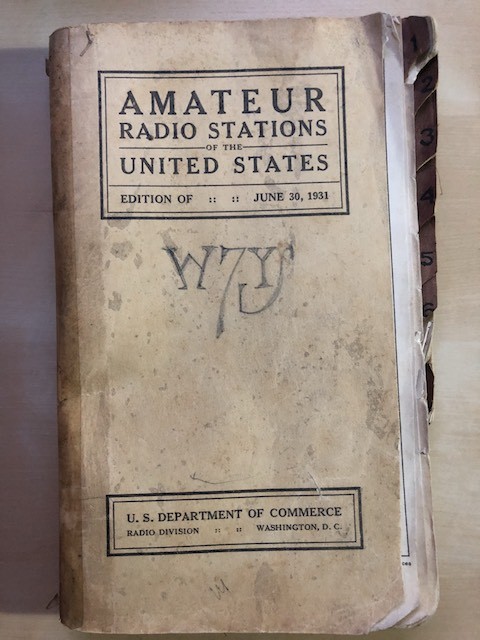

One expects that the listed station trustee is likely the same person as John M. Jeffords '27 who performed in various student groups including the Klef Klub, Varsity Quartette, Varisty Show, Glee Club, and a radio performance on station WEAF. (Source: various issues of the Columbia Daily Spectator.)

Major Edwin Howard Armstrong(1890-1954), inventor of the regenerative receiver, superheterodyne circuit, and FM radio, did much of his pioneering work in radio at Columbia as an undergraduate (entering in 1909), as an instructor and assistant to Michael I. Pupin and, years later, as a professor of electrical engineering. For an excellent biography, see Lawrence Lessing's Man of High Fidelity: Edwin Howard Armstrong. Also, the PBS series, Empire of the Air features Armstrong. See also, Edwin Armstrong: Pioneer of the Airwaves by Yannis Tsividis, the E. H. Armstrong web site, the Edwin Howard Armstrong Papers at the Columbia Rare Books and Manuscripts Library, Jen Comins' Armstrong Papers blog (warning: this is a 500MB+ web page!), and the Armstrong Memorial Research Foundation.
Radio station W2XMN was built by Armstrong in Alpine, NJ in 1939 and operated for 16 years demonstrating high fidelity FM radio. You can clearly see the Alpine radio tower today sitting atop the Palisades opposite Yonkers, where Armstrong lived as a child and performed his first radio experiments. On a related note, WKCR FM, Columbia University, was one of the earliest FM broadcast radio stations.
See WKCR's history which describes the founding of WKCR, the Orginal FM:
"The Original FM": The Columbia University Radio Club
On July 18, 1939, a 400-foot antenna tower in Alpine, New Jersey broadcast the very first FM transmission. Edwin H. Armstrong, a Columbia University professor, was the first to develop this alternative to traditional AM broadcasts. WKCR shares a history with Armstrong and his groundbreaking work, accounting for the marginally accurate phrase, "The Original FM" occasionally heard on-air. Beginning as the Columbia University Radio Club (CURC) as early as 1936, the organization was not a radio station as we know it, but rather an organization concerned with the technology of radio communications. As membership grew, however, the nascent club turned its efforts to broadcasting. Armstrong helped the students in their early efforts, donating a microphone and turntables when they designed their first makeshift studio in a dorm room (1107 John Jay, to be precise).
And see a contribution from Les Balter, W2HRT (SK) that also speaks to WKCR's founding:
I graduated 41E. In 1938 or 9 I was chief op. I hold W2HRT since 1934. The club at that time was more taken with FM promotion and demonstration than ham radio. I spent time at the Alpine tower W2XMN. I recall a specific demo trip the club made to Brooklyn Polytech. W2XMN went on the air for us and we carried our one and only FM receiver in a 6 ft. rack to Brooklyn to demo the advantages of FM. In 1939-40 Bill Hutchins 40E got the club to organize a campus radio station. At the time it was totally illegal. FCC regs permitted 5 (?) microvolts per meter radiation from a carrier wire. We put CURC (call letters used) "on the air" as a carrier current station using the power wires as conductor. We operated at about 620 kc AM . The lower the frequency, the greater distance allowed. The club assembled the console and am transmitter from scratch. I personally remember hand wiring rotary switches to make the operating console. Also remeber technical problem of coupling around power distribution transformers to get the signal to Barnard, which we did.
In March 2013, Tony Ricicki W2VRK, an amateur radio historian, brought to light some information regarding CURC in 1939-1940. In March 1940, CURC participated in the Twelfth ARRL DX Competition. Tony W2VRK sent Ed Miller KD2DDT, club president in 2013, an award given to CURC.
The award was given to Liscum Diven W2HHF (SK) and also mentions two other hams: W2IZO and W2KHA.
W2IZO is currently an unoccupied call and so is assumed to be a silent key. Tony W2VRK, from information in his 1939 callbook, indicates that W2IZO was G. L. Hesse of 107 Lewis Parkway, Yonkers NY.
W2KHA is Art Westneat Jr., currently W1AM.
Tony W2VRK provided a QSL sent from Art, then W2KHA, to Liscum W2HHF in January of 1940. Ed KD2DDT contacted Art in March 2013 to ask about his recollections from the club with the hope of filling in information about this time in the club's hitory:
Hello Edward, I am most pleased to hear from you, and to learn of your project. I fear that I can't be of great help to you, really.
Here I am, not far from 92 years old, living in Durham, NH, a very nice old college town. I have held a continuous license since 1936, but am QRT now. I have had a very busy active life, and my ham careeer included working 345 countries as a DXCC total.
In Sept. 1939, I appeared on 116th St, as a freshman, all set for a big run at the prize, fresh out of High School. I was enrolled in the general Freshman course, which included much Philosophy, Economics, broadly based reading, wonderful discussions with faculty and staff. One fabulous year, the only year of real education I was ever to get. I worked very hard academically, got a huge amount out of it, and bless Columbia even today.
Recall 1939 - 1940. Germany had invaded France, Roosevelt was dealing Lend-Lease. But we were at peace, so why worry? I worried. All around me were able and bright young men. It was clear to me what our fate, my fate, would be, and I knew what a Liberal Arts degree would buy me on the beaches. I hung it out for a year, and left Columbia for Purdue, which I perceived to have a much more Nuts & Bolts Engineering program. By focusing immediately on Engineering. with my Ham background, I would stand out from the average crowd. I did, and after graduation in '43, worked out the war at Columbia of all places.
So there I am as a "potential' piece of CUARC history. I was active in the Club, but there wasn't much going on. Ham Radio was soon to shut down and we all soon dissipated. Perhaps I could remember the names of some of the members if I thought about it. I did work W2AEE once, but never got a card. as all my QSL cards but I am sure there is none of the Clubs. Try as I might, I can not think of any memory I had dealing with the Club in that year at Columbia. For people driven like me a hobby was totally secondary and I focused little on the amateur radio part of my past.
CUARC is probably one of the most distinguished college-amateur clubs in the Nation. Before I got there the members were working with Major Edward Armstrong on FM development. All that had dissipated by 1939, and no new focus had appeared. In the years since I have run across W2AEE several times, and am delighted to hear the you are leading it on. I wish you much success. I do wish I could contribute more now.
With the best of wishes for your career.
Arthur S. Westneat W1AM, now. Then W2KHA
After forwarding Art W1AM the ARRL DX Competition award listing Liscum W1HHF and himself as participants in the award, Art shared his recollection of Liscum W2HHF as well as his (Art's) personal station at the time:
Hello Ed, Thanks for the added notes.
Liscum Divum, W2HHF, is a major memory of my year at Columbia. An upper classmate, disdainful of Freshmen, and basically aloof and introspective, he did however communicate to some degree. Liscum was essentially the top DXer in the US at the time. I recall that his country-worked total was something like 150 countries, inconceivable in the 1930's-'40s. He had a complex long wire array. I did work him once from home. His QSL to me now is in the hands of Tony W2VRK, who was kind enough to give all my cards a home. I am delighted to hear that my card to him has survived.
It is remarkable to me that my activities as a youth of 18 years is attracting historical interest!!!
I had forgotten about the 1940 DX Contest. I am sure I would have joined in, My station was of low power, receiver output tubes, 50 watts ?, and my score could not have been high. You have no idea of the depth of poverty that we lived in, in the slums of Jersey City. My Father's salary in '39, was $20 a week. All 3 of his son's got advanced college degrees, and achieved Professional careers. In passing, it was a remarkable achievement.
Thanks for the info.
-Art W1AM
Amateur radio was shut down by the government for the duration of World War II. There appear to be no surving club records from this period.
In June 2013, Tony Ricicki W2VRK, again provided the club with more historical information by putting Ed Miller KD2DDT, then club president, in touch with Sterling Fisher KD6Z, an alumnus from Columbia that was around right after the war ended. Sterling provided this account of what things were like back then:
Ed,
Glad to meet you! My call in 1946 was W2PEX and I lived in Tarrytown, N.Y., commuting down to Columbia daily on what was called the New York Central RR at the time. You are very welcome to add the material I sent Tony to the club's history page. I am happy to be able to contribute to it.
I guess Tony mentioned the old magazines I sent him, too. They do have an interesting provenance. There was a "Wireless Age" from September 1914, QSTs from February and March 1916 and one called "Everyday Mechanics" from December 1915.
All four originally belonged to Edwin H. Armstrong, the inventor of FM. Back in 1948 I was a Laboratory Assistant at Columbia, working toward my Masters degree in EE. Armstrong had a lab there which he seldom used. At one point, the lab overseer decided that a number of books and magazines were duplicates or unneeded and made them available to the staff. I was fortunate enough to acquire those magazines. Even then, they were ancient.
The Columbia club station, W2AEE, never got on the air while I was there. I was trustee of it for a while, though! Here's how it happened.
After WW II ended, hams were allowed back on the air in late '45 or early '46. I got my Class B ticket on May 1, 1946 and my BSEE from Columbia Engineering in June, 1946. That September I started on my Masters, working part-time as a Laboratory Assistant. Some time after that the Dean of the Engineering School decided it would be a good idea to reactivate the radio club station, W2AEE. It would need a faculty/staff trustee, of course. Well, it turned out that I was the only one there with a ham license, so I was elected.
With great anticipation I climbed the circular staircase from the top floor of Engineering up into the attic space where W2AEE was located. Thick dust covered everything. There was no attic ceiling, just the underside of the copper roof. It was hot. There was an old receiver and some old equipment from the '30s. Nothing organized. I found a hatch in the roof and climbed outside to see what the prospects were for an antenna. Nothing. The copper roof sloped down from the spine to the gutter with an abrupt drop to the street six stories below. No pipes or housings that could be used.
I could not afford the time or effort it would take to reactivate the station, so it sat as I had found it through July 1948 at least, when I left. No faculty or students showed any interest that whole time.
So there's the story!
73,
Sterling Fisher, KD6Z
In 1946, the School of Engineering was housed in what is now the mathematics building .
Sterling, also provided an account of the Columbia engineering education that was available at the time:
Ed,
A note for the "how times change" file:
When I enrolled at Columbia in 1943 you could choose between (I don't like 'among' here) Chemical Engineering, Mechanical Engineering, Electrical Engineering, and Mining Engineering, as I recall. The School of Mines had a whole building to itself.
In Electrical Engineering you had just two choices: Power and Communications. I chose Communications, of course. Even so, when they taught transmission line theory, one of the first examples they worked with was standing waves on long-distance power transmission lines at 60 Hz. (or cycles per second, as it was then). This sounds terribly primitive, I know, but it was very important in the power business then - and probably still is, for that matter. They did get around to advanced courses in mathematics, circuit design*, communications theory, electromagnetic propogation, etc. but there was no specialization beyond Power and Comm. I'll bet there are a few more choices now…
I know this sounds archaic now (that's mainly why I wrote this P.S.) but it was basic knowledge that allowed graduates to keep up with and contribute to an ever-changing field.
Sterling
*Using vacuum tubes only. Transistors weren't even invented until 1947.
1950 - 1969
An antenna history covering the 1950's in detail and containing some details back to 1906 was recently unearthed in the shack files and is the basis of much of the information above.
Fuat, N2YGN, found an ARRL Charter of Affiliation dated July 10, 1953....
In 1954-5, Vincent O'Keeffe, W1IDL, was involved with the club and sent us this letter in November, 1998 describing rigs of the day including Gonset Communicatiors, and the innauguration of Dwight D. Eisenhower as Columbia's thirteenth president.
In 1956-57, Yves "Al" Feder, W1EOX (ex-K2CUI), was Vice President of the club and later trustee. Yves has provided a lot of information about that time.
On October 4, 1957, Sputnik 1 was launched by the Soviet Union, and W2AEE was there (and the FBI too!)
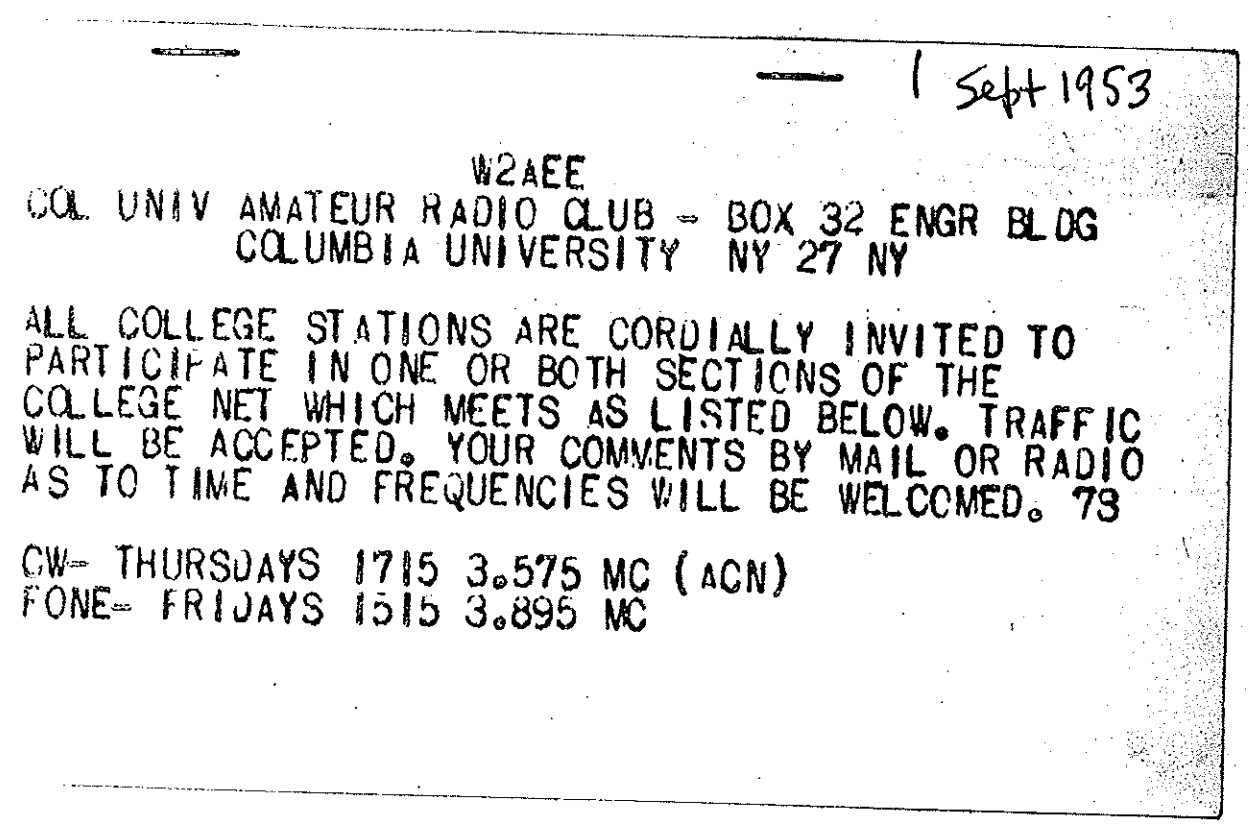
In Winter 1950, NYU's Amateur Radio Club proposed formalizing the All-College Net which by the mid-50's appeared to be going strong. A few samples from the files:

In April of 1959 a feature article about the club appeared in the Columbia Daily Spectator containing a multitude of information.
The article lists the following pieces of information:
- The club telecast the Childs Cup Regatta from the Harlem River to receivers in John Jay lounge and at the finish line.
- The club is stated to have formed in 1906.
- The club was formed by Professor Michael Pupin and Edwin Armstrong.
- There is corroboration of the Sputnik story, here mentioning that the Pentagon received tapes of a recording of Sputnik by W2AEE, rather than the FBI.
- The shack was located in 700 Engineering
- The club had seven antennas at the time.
- The club had received the 'Worked All Continents' certificate by the International Amateur Radio Union.
- The club had received the 'Worked All States on 75 Meter Phone' certificate by the ARRL.
The two most incredible pieces of information are the claims that the club was founded in 1906 and that Edwin Armstrong was part of the club's founding. The claim of a 1906 founding may be true based on the Antenna History of the club dating back to that year. However, we have no corroborating evidence of Major Armstrong's involvement in the club. Although it is undisputed that the club and Armstrong were contemporaries during Armstrong's tenure at Columbia (both as a student and a professor), no definitive evidence has been found that Armstrong participated in the club's activities. Nonetheless, this article in the Columbia Daily Spectator indicates that by 1959, the club already considered, either apocryphal or not, Armstrong to have been part of her (by then already) storied history.



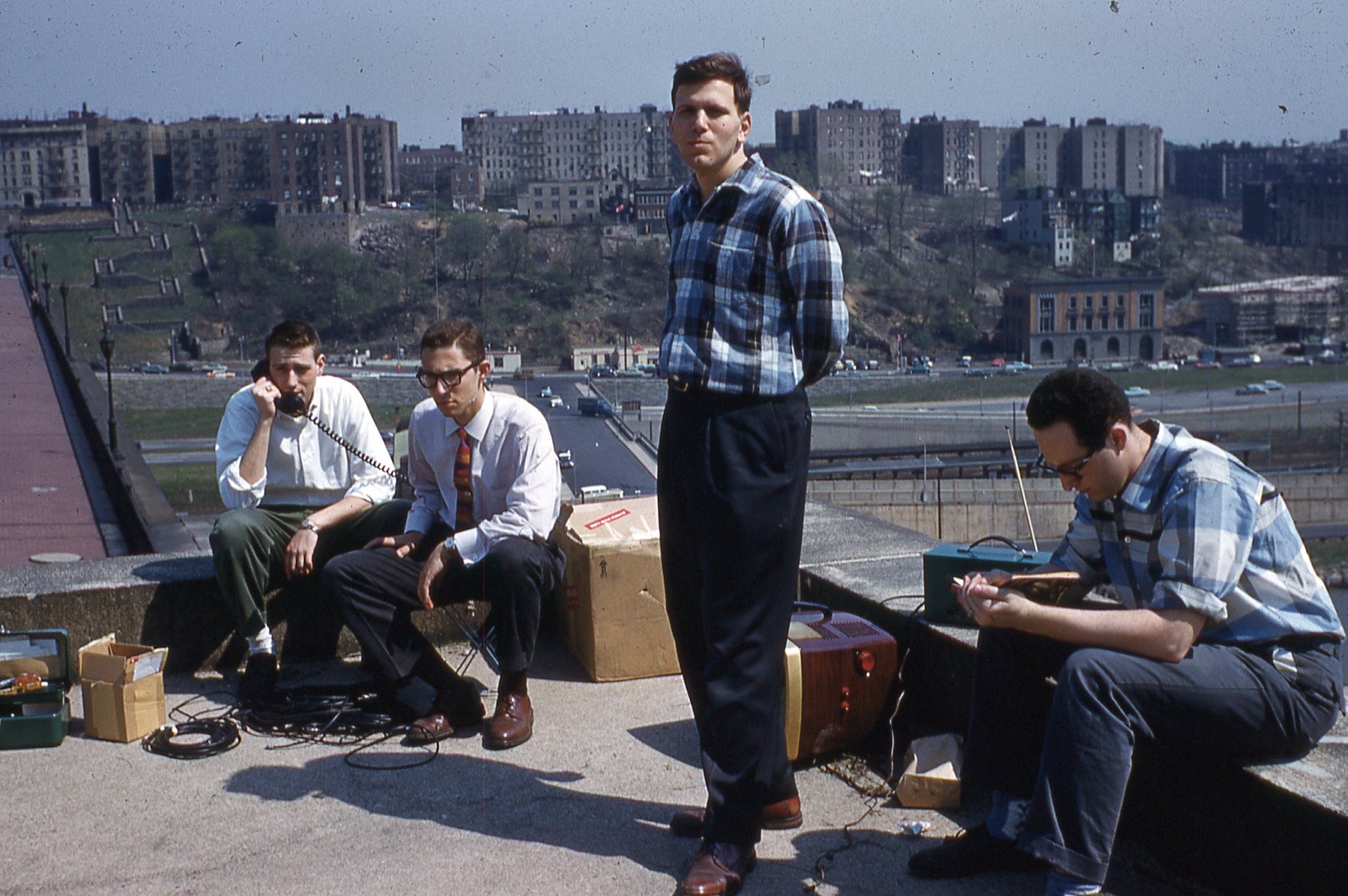

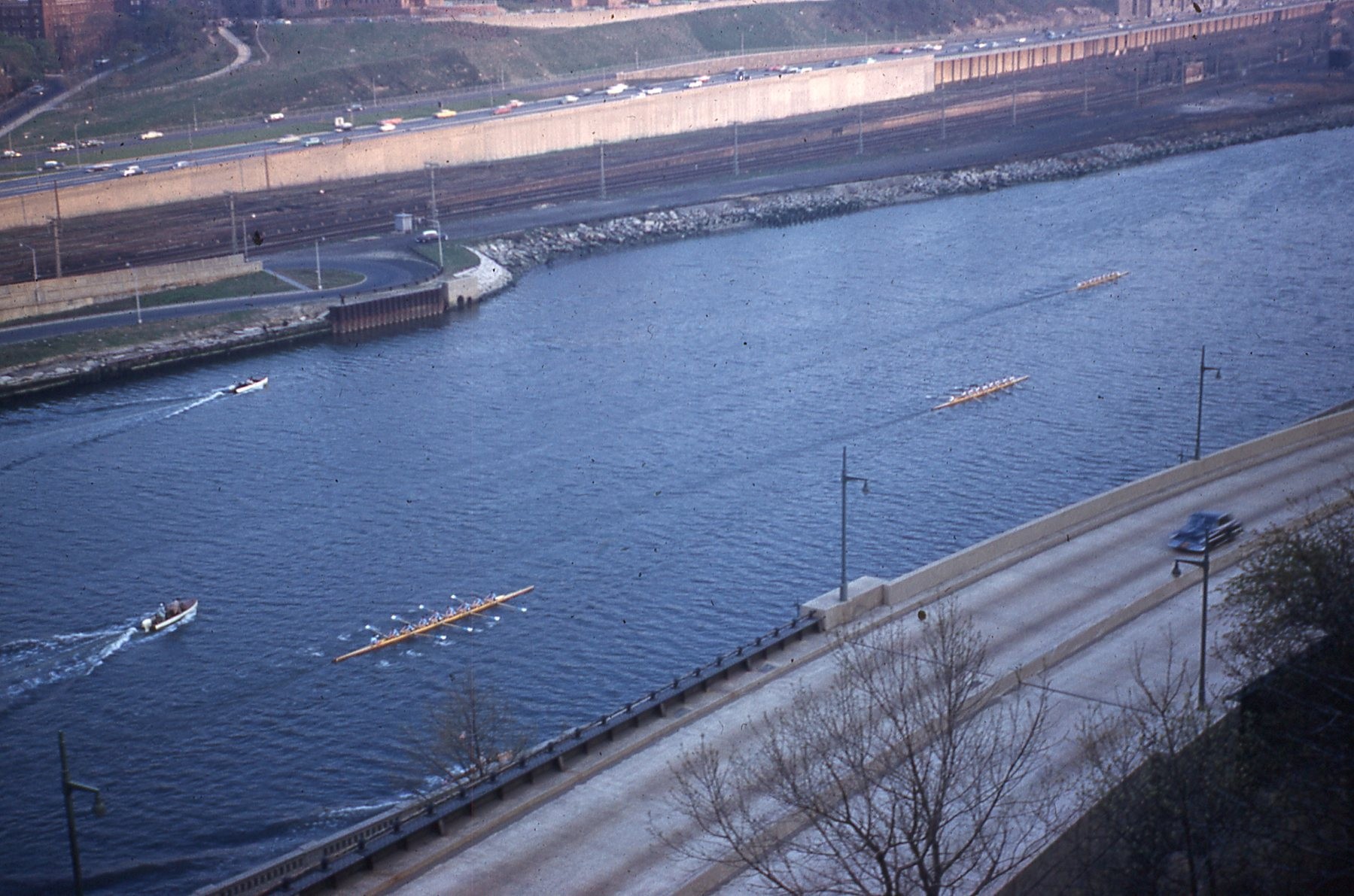
The preceding photos and accompanying information were received in December 2021 from Bob Norin, W7YAQ.
Bob attended Columbia College and the School of Engineering from 1958 to 1963. The photos are from the Club's attempt to televise the 1959 Childs Cup Regatta from the High Bridge. Bob also operated W2AEE in the 1958 ARRL CW Sweepstakes and 1959 ARRL DX CW Contest.
After receiving the BSEE from Columbia, Bob went on to get a MSEE from Stanford in 1964, served in the US Navy 1964-67, and got a PhD in EE from Cornell in 1970. After an engineering career in industry, primarily developing high-performance software, He retired from Intel in 2007. Since 2007 he has lived in Sisters, a small town in central Oregon.



Before relocating to the newly-built Seeley W. Mudd Building, the shack was located in the old Engineering Building, now Mathematics Hall.
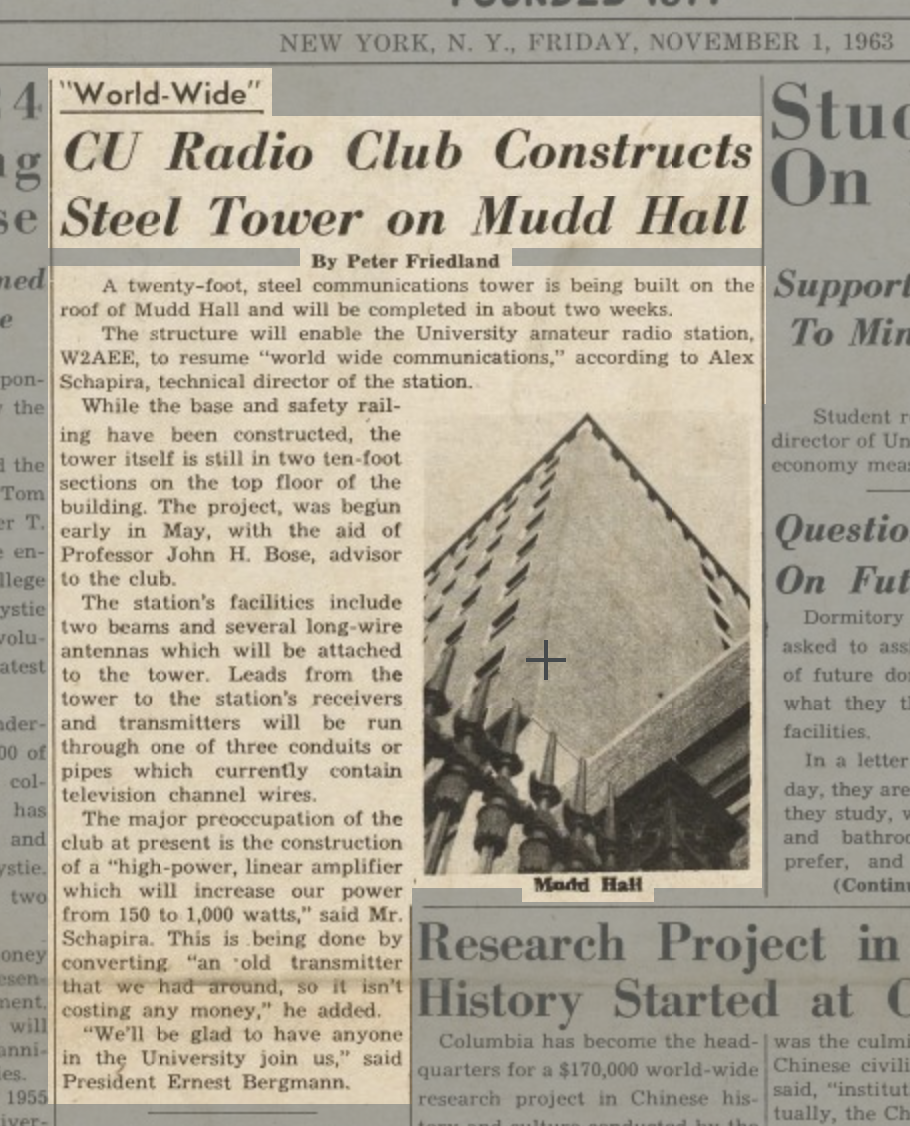
During this time, the club moved from the old Engineering school building, now Mathematics Hall, to the new building, Seeley W. Mudd Hall, where it is currently located. Given that, most files found in the shack date back to the late fifties and early sixties.
CU Radio Club Contructs Steel Tower on Mudd Hall
A twenty-foot, steel communications tower is being built on the roof of Mudd Hall and will be completed in about two weeks.
The structure will enable the University amateur radio station, W2AEE, to resume "world wide communication," according to Alex Schapiro, technical director of the station.
While the base and safety railingg have been constructed, the tower itself is still in tow ten-foot sections on the top floor of the building. The project was begun earuly in May, with the aid of Professor John H. Bose, advisor to the club.
The station's facilities include two beams and several long-wire antennas which will be attached to the tower. Leads from the tower to the station's receivers and transmitters will be run through one of three conduits or pipes which currently contain television channel wires.
The major preoccupation of the club at present is the construction of a "high-power, linear amplifier which will increase our power from 140 to 1,000 watts," said Mr. Schapiro. This is being done by converting "an old transmitter that we had around, so it isn't costing us any money," he added.
"We'll be glad to have anyone in the University join us," said President Ernest Bergmann."
– The Columbia Daily Spectator. 11/1/1963.
DUNNING CELEBRATES RADIO CLUB EXPANSION
Last Thursday, Dean John R. Dunning made the final connecttion between the Radio Club's transmitting and receiving equipment on the fourteenth floor of SWM and its new antennas atop the highest roof of the Mudd Building.
The club just recently moved into the Mudd Building from the old engineering building, now the mathematics building. A "shack" was constructed for them in the elevator lobby on the fourteenth floor of SWM, and antennas have been partially completed on the roof. Lead wires of 150 feet have been put in place to connect the antennas and the shack, In the picture adjacent to this article, the antenna nearest the top of the mast Is used for the two meter ham band. The lower antenna is one section of a "tribander" beam which is for use on the 10, 15, and 20 meter bands,
These latter bands bands, especially the 15 and 20 meter bands, are of special interest because of their distance capabilities, under good conditions, it is expected that contacts will be made with every continent, The club hopes to install remote control rotating equipment, which would enable them to direct the antenna from their shack, in the near future,
New Transmitter Purchased
The club has just obtained a new high-powered transmitter capable of one kilowatt input power, This unit, which is almost totally automated, was obtained by the club at a nominal cost, The original cost to the Unites States was somewhere on the order of $50,000, The units are surplus which are being made available to educational institutions for almost no cost. To give an idea of the precision of this instrument, it tunes itself and is capable of a frequency accuracy to the nearest ten cycles per second.
Started in 1907
The first records of an amateur radio station at Columbia indicate that, in 1907, there was a spark-gap transmitter located In the basement of Chandler hall. Later the club moved to the old engineering building, where it remained until its recent move to SWM, There was a hiatus of approximiately one year in the club's operation while the move to SWM was being undertaken, At present, the club has twenty-five members and it is expected that the number will increase since the club is operating again.
Offers Code and Theory Classes
The club is presently conducting code and theory classes at 6 pm every Thursday at the shack, The purpose of these classes is to "teach all those interested in the necessary knowledge to pass the FCC license examinations," according to Ernie Bergmann, the club president. The club's phone extension is 726 and all those interested are invited either to call or to come up to the shack.
1970 - 1989

The background of a strange letter in the files from the FCC (citing a violation of Section 97.39: Transmission of information of a non-amateur nature in behalf of a non-amateur organization) was recently explained by Wayne Mueller, W1QC: "You should have in the files a letter from the FCC citing illegal transmissions back in the late 60's or early seventies. The club was actually used during the student uprisings for some sort of 'activist' communications."
Further investigation found the station log book and the page for that period shows a series of contacts with the National Student Information Network [Kristen Haring. Ham Radio's Technical Culture. 2007. MIT Press (retrieved via Google Books, 2/11/2011). p. 30]. These contacts were likely in response to the student strike and killing of 4 students at Kent State University on May 4, 1970.
Excerpts from the station log for May 8, 9, and 11 (the May 10 date of the FCC violation notice is not in the log) show contacts on 40 and 80 meters with (on the same frequencies of 3.930 and 7.269 MHz, likely indicating a scheduled net): W2UC, Union College, Schenectady, NY; W2DSC, New York University; WA2FJM, currently registered to John L. Breese; W1WGM, currently not registered; WB2BMM, currently registered to Ben L. Bason.
There's a log notation that states "Worked W2MJ to pass Senators message." Unfortunately, the log does not indicate who the W2AEE control operator was or more information about the content of the message.
An over the air chess competition with Harvard was won handily with a "secret weapon."
An annual report and budget request from 1971 (for $600) describes club activities of the day including experiments with radio reletype (RTTY), Amateur slow- and fast-scan TV (SSTV, ATV), plans to marticipate in the Military Amateur Radio Service (MARS), and OSCAR satellite communications, phone patches run for several students to Israel, Brasil and Peru, and so on.
On the Cover of March 1976 QST
W2AEE made the cover of March 1976 QST with a stunning photo taken by Bob Spitzer, WB2DZL, looking downtown along our Mosley Classic 36 HF beam from our rooftop tower on the S.W. Mudd building. This cover photo was the inspiration for our 1994 QSL card.
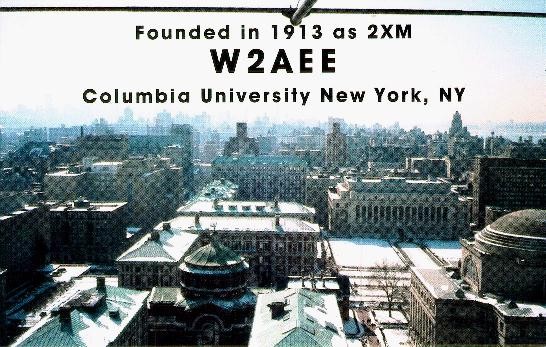
In 1977, Columbia University President William J. McGill, SK, through the help of CUARC President Joshua Mermelstein (1976-1977) and the club, obtained his Novice Class license. Here is a press release issued by the Office of Public Information on 4/14/77:
President McGill donated some equipment to the club. Notably, the Kenwood HF rig that was still in use well into the 21st century.
- Here's a publicity flyer from 1976-77.
- And here's an offer to take National Traffic System radiogram traffic, undated, but probably from the same time period.
- Here's a description of the station signed by Fearless Leader Bob Spitzer, WB2DZL, now KB1AP, also undated. Bob reports that he revitalized the club from dormancy to 20 to 30 members, including erecting the HF tower.
Josh helped to get the club rejuvinated in the mid-seventies. Joe Schachner WB2FUL was president from 1977-79 and helped freshman Wayne Mueller get licensed in Spring 1977 as WD9EAV. Wayne, now W1QC (ex-AE9B) was president from 1979-80.
Wayne reports, "There was a member in '77 and '78 who was great at building things. He built a great RTTY TU for the old green teletype we had. I wish I could remember his name." Andrew Siegel, N2CN (ex-WA2BDV), reports that the TU was built by Joe Geller, KO2Y. Joe and Andrew, while a high school student in the Science Honors Program, built an Az-El rotator for OSCAR. The club also acquired an ICOM multimode VHF rig.
During 1980-1983, Ray Ihly, WA2LVY, was CUARC president.
CUARC also installed radio equipment at Columbia's Arden House in 1982.
In 1984, Adam Epstein, N2DHH was president.
Doug McArthur. KH6IQD (now N0HQ) was a member of the club from 1980-1982. On May 22nd, 2015, he returned to visit and logged a bunch of contacts.
A report and budget request (for $799) from 1981 lists the club membership at the time (showing undergrads from SEAS and CC, several graduate students, a member of the physical plant staff and two faculty. The report also describes activities including receiving SSTV images from Voyager I.
1990 - 2009
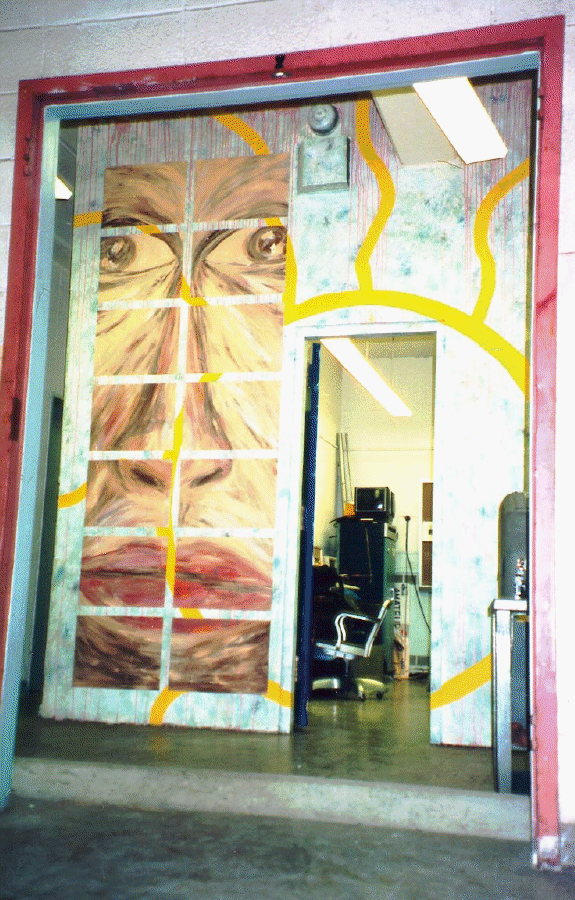
Besides fairly active general radio fun, a number of items of special interest have happened during this period:
- In May 1992, Hank Alvestad helped preserve E.H. Armstrong's legacy by donating a binder of circuit diagrams and notes from Amstrong and his staff.
- In 1993(?) a Volunteer Examiner team started running amateur radio exams on campus.
- An Emergency Operations Team, affiliated with New York City ARES (Amateur Radio Emergency Service) was formed and even activated during the December, 1994 winter storms to provide emergency communications at a Red Cross shelter.
- Several CUARC members participated in the 1993 and 1994 New York City Marathon, along with about 400 other hams.
- In the Spring of 1994, we had a Fox Hunt in Central Park. Mike, KK6SQ, was the fox and turned out to be hiding in the tower of the Castle.
- In September 1994, we ran several special events during Orientation week, including taking over 80 NTS messages at Barnard and on College Walk and we operated an HF station on College Walk.
- In February 1998, while making preparations for an Alumni antenna party spurred on by Wayne Mueller, W1QC, Alan, N2YGK, and Fuat, N2YGN, took these photos of the upper rooftop to document the condition of the current towers and feedlines:
- HF tower in good shape. Mounted antennas include Mosley CL-36 tribander and 2 M vertical. Rotator needs repair as does rotator cable which has broken insulation. CL-36 appears to be sound.
- VHF/UHF tower is rusty but otherwise OK. Mounted antennas include azimuth-eleavation rotator holding 2m Yagi and 70cm phased Yagis and 70cm vertical. The azimuth rotator mounting bolts have dissappeared and need to be replaced. Looks like one of the 70cm Yagis is missing two elements.
- G5RV is broken.
- Coax/rotator cable work box is in good shape. There are 5 coax feed lines and three rotator cables into the box. Cover came off very easily and it is clean and dry inside. All 5 feeds are connected: Mosley, 2m vertical, 70cm vertical, 2m vertical Yagi, 70cm horizontal Yagi.
Thanks Rob, KA2FZI, for the loan of the digital camera and "foto rush" services
See also Mike Cecere's Spring '94 shack report.
We're still here, limping along
- In June 2005 the state of the shack is:
- The Mosley CL-36 HF beam has died. One half of the driven element fell off.
- The HF rotator that Wayne replaced in 1998 is still working.
- The 160-80-40 wire antennas that Wayne installed are showing a high VSWR
- The Kenwood TS-830 donated my Columbia President Bill McGill in 1977 is still working although it needs some cleaning.
- The Kenwood TR-751 VHF all-mode rig looks fine.
- We also have an old ICOM UHF rig on loan from WA2USS.
- An APRS digipeater has been in continuous operation since the 2001 NYC Marathon.
- The APRS digi, W2AEE, is using the 2m vertical.
- State of the VHF tower is poor. Needs to be taken down.
- The VE team is still active doing monthly exams.
- Philosophy Hall was added to the National Register of Historic Places for E.H. Armstrong's pioneering research there.
- On June 11, 2005 the 70th Anniversary of FM was recently celebrated with a special broadcast from Alpine Tower on 42.8 Mc.
Sadly, our centennial went by in 2008 and nobody noticed. I suppose we can always go with the 2013 centennial of 2XM!
2010 - 2029?
A project to organize the papers of E.H. Armstrong (in the Columbia Rare Book and Manuscripts Library), championed by Mischa Schwartz, supported by the Armstrong Memorial Research Foundation, the IEEE and others, and staffed by Jen Comins, along with we hams' attempts to claim Armstrong as "one of us" as found in editorial comments accompanying a November 1933 letter from Armstrong to QST announcing his victory over Lee DeForest confirming his invention of the regenerative receiver:
...This is a subject of great interest because Armstrong, at the time of inventing the regenerative feedback circuit, was himself a 23-years-old amateur. His work is frequently pointed to as the outstanding example of the amateur's ability to contribute to the art....
There's been some renewed interest in the history of the club thanks to:
- The 75th anniverary rebroadcast of the 70th anniversary 42.8 Mc celebration.
- Gintautas Gaidamavicius, LY2YR, who found a New York Sun article about the founding of the club in 1908.
- The recent availability of searchable QST archives, which also led to some interesting insights about the club founding – and a friendly rivalry with MIT that dates back to 1958. Get over it guys. We were first.
- Letter to the Editor of QST published April, 2011, again restating our 1958 claim against the MIT Radio Society's primacy as the first college ham radio station.
- On June 7, 2011, Jen Comins and Jocelyn Wilk carted off four boxes of old files to add to the Columbia University Archives, helping to preserve the history of the club.
W2AEE joined the new College Amateur Radio Club Association in April, 2011.
The VE Team is still active as well.
2012 - QRV 70cm to 80m
2012 was a big year for CUARC as the club saw lots of rejuvenation.
- On January 1, 2012, Alan Crosswell, N2YGK and Ed Miller, KD2DDT installed a 2m/440 dual band antenna on the tower, getting us back on the air for VHF/UHF phone.
- Ed Miller (KD2DDT) took over as Club president and got the club recognition through the Graduate Student Activities Council.
- We've had a lot of generous donations:
- Alan donated the Larsen Omni.
- Monica Pedone (KV2O) donated her Yaesu FT-707 HF Rig in February.
- Tom Raffaelli (WB2NHC) donated his Hygain Explorer 14 which we used to replace the Mosley CL-36 in September.
- Martin Miller (KD4DDT) donated his Kenwood TS-450S HF Rig in September.
- Anonymous friends donated the 2m trombone for the APRS digipeater.
- New guy wires for the 30 foot tower were bought with funds donated by Alan (N2YGK) and Joe Schrabal (WA2USS).
- From a grant from the Graduate Student Activities Council, we bought a Radiowavz G5RV making us QRV down to 80m.
- Alan (N2YGK) installed a new exhaust fan in the shack.
- We got a treasurer: Hy Chantz (W2HY).
- And we got a faculty sponsor: Professor Ed Coffman.
The CUARC webpage was completely redesigned this year and now runs on a Confluence wiki.[And now in 2018 it doesn't - Ed]
With the G5RV and Hygain Explorer 14, and with the Yaesu FT-707 and the Kenwood TS-450S we're now able to have 2 hams operate simultaneously on HF.
Thanks to the following hams for donating their time, talents and tools over the many Saturdays and Sundays of 2012 to make it all happen:
- Ed KD2DDT
- John KE2UN
- Alan K2ARN
- Bob N2DVQ
- Dwight N2FMC
- Adam N2DHH
- Alan N2YGK
- Hy W2HY
We ran a special event station on 11/23/2013 to celebrate the 100th year of the 2XM call sign, logged 24 contacts and had plenty of pizza.
Here's the poster.
The Columbia University Amateur Radio Club is running a special event station to commemorate the 100th Anniversary of our first call sign, 2XM.
We'll be operating under the special event station WA2XM and offering QSO certificates for confirmed contacts.
Funding
Obtaining a certificate
For confirmed 2-way contacts, a QSO certificate is available. To receive a QSO certificate send a self-addressed stamp envelope to:
Columbia University Amateur Radio Club c/o Edward Miller,
3000 Broadway, MC 3136,
New York, NY 10027
USA
A digital copy of the personalized certificate is also available. To request a digital copy send an e-mail
to: ebm2134 at columbia dot edu
subject: WA2XM QSO Certificate
For either method of requesting a certificate, please provide your call sign, time of contact, and band so that we can confirm with a lookup in our logs.
Shack Report by Alan Crosswell, N2YGK
Good
- APRS PC repaired & UPS replaced. Software installation still in process but should be OK in time for the NYC Marathon. No more beeping UPS! Temporary antenna on Vertex radio (see below).
- Air conditioner was installed by someone - much appreciated.
- Lots of furniture and equipment moves make the space more open.
- G5RV was replaced.
- Lots of random donated rigs, chairs, and other equipment.
- The horrible mess of several months ago has been (mostly) cleaned up.
Bad
- Some antennae left disconnected, nowhere near where the radios got moved and no signs indicating so. We have no functional 2m or 440 due to this. (Furthermore, since the Trombone antenna for APRS appears to be broken, I've borrowed the former 2m/440 antenna for this purpose so I guess I don't feel guilty;-) I've put "out of service" signs on those 2 rigs.
- HF rotator, etc. also appear to not be connected. So it's looking like we only have a G5RV on HF right now.
- Still too much crap all over the place, tools not put away, etc.
- No evidence of the station logbook showing operators signing in and out.
- Station license that was hung up on the equipment shack is gone missing.
- Too much donated stuff piled around (especially old PCs).
July 2017
The rebuilt T2X rotator is installed and working great. The last rebuilt rotator (also from Norm's Rotors, donated by Wayne Mueller, W1QC) was installed in 1998, so I don't think I'll be personally climbing the tower for the next replacement;-)
I noticed a screw missing from the matching element bracket so we'll probably need to do another minor repair soon. (I'm ignoring the major things like the old rusting 2nd tower. :-)
I believe I saw one of our crew take a photo of the opened roof box. That'll be good documentation to add to the wiki, which is in the midst of an upgrade right now....
Thanks to John Brooks, Matt Bajor, Nick Flowers, Alain De Carolis and Bob Wilson. And thanks to the Graduate Student Activities Council (GSAC) for funding this repair and other stuff the last couple of years.
73 de N2YGK
2018 has seen increased activity with (pretty) regular monthly meetings on the second Friday at 6pm and weekly Saturday operating hours at 10am, mentored ("elmered") by Alain, K1FM. Many new hams have made their first HF contacts from W2AEE and the QSL cards and HRDLOG entries are piling up with domestic and DX contacts.
We've also moved to a new web site, had some equipment updates, shack cleanup work and recent donations.
As has been the case for decades, the Volunteer Examiner team consistently conducts monthly exam sessions with candidate turnout averaging over six people per session.
The Amateur Radio Club collaborated with the Columbia Space Initiative (CSI) to create a mobile tracking and communications platform to communicate with satellites in low Earth orbit (LEO). On Saturday August 11 at 12:55pm they worked Dr. Serena M. Auñón-Chancellor (KG5TMT) aboard the ISS.
See the article at the CUEE web site and archived here (just in case).
For most of 2020 the shack was closed due to the COVID-19 Coronavirus pandemic. Starting in late March, the Volunteer Examiner team joined a group of other VEs from around the US in proctoring online ham radio exams. As of December 9, 2020 the online VE team, composed of members of CUARC and close to 50 volunteers from around the world served 347 candidates in 96 nightly exam sessions, running just about every Monday, Tuesday and Wednesday evening.
Zoom, the verb/noun that took on a heightened meaning in 2020, along with HamStudy/ExamTools was used to proctor each session, which requires at least three Volunteer Examiners to watch each candidate take the test.
A nice article in The Blue and White Magazine December 2020 issue quoted club president Brian Ahn, KM6CXL. The article, "Anyone There?," is reproduced below and is saved here as PDF for posterity [as this editor knows how fickle web sites can be].
Blue Notes, December 2020
In which our writers find strength in virtual communities, hope in forming connections, and trouble in defining Columbia’s legacy.
DEPT. OF FREQUENCIES
Anyone There?
By Elizabeth Jackson
Look up as you stand in my grandfather’s backyard, and you’ll see an imposing antenna stretching to pierce the sky, like an enormous metal index finger held up to test which way the wind is blowing. This is no mere television antenna.
This contraption, coupled with the shelves of neatly aligned equipment in his “radio room” (once my uncle’s childhood bedroom), facilitates my grandfather’s favorite hobby since 1972: amateur radio.
Illustration by Kat Chen
Amateur radio, frequently termed “ham radio,” is a method of two-way communication through which licensed operators contact each other by transmitting radio frequencies at levels allocated by national communications authorities—in the U.S., the Federal Communications Commission (FCC). There are three classes of amateur radio licenses: technician, general, and extra. These licenses require separate exams and confer different operating privileges: Extra class licenses allow operators to transmit on any frequency designated for amateur radio, while general and technician licensees are more restricted in the frequencies they are allowed to use. These restrictions have implications for how far an operator is able to transmit under particular atmospheric conditions. Transmissions take various forms, including Morse code and voice communications, and operators can even link computers to their radios to send data like text and images via satellite.
Amateur radio has been widespread since the early 20th century. We now live in a world saturated by more modern communication— texting, social media, cell phones—yet there are still more than two million amateur radio operators worldwide. Teacher’s College student Brian Ahn, president of the Columbia University Amateur Radio Club (CUARC), is one such operator. Ahn became involved in amateur radio primarily because of its important role in disaster response and preparedness—more specifically, “because of its ability to save lives, or ability to use communication in emergencies to give to different responders—emergency responders—so that they can do their job.” Discussing a group that coordinates amateur radio service efforts, Ahn emphasized: “It’s all about keeping the community safe.” Because amateur radio does not require the internet or a cell phone network, it is often the only form of communication available when disasters, like hurricanes or massive floods, strike and damage infrastructure.
Ahn was first introduced to amateur radio in 2016 while working for Americorps. Later, when working for the Federal Emergency Management Agency (FEMA), he was deployed in response to Hurricanes Harvey, Irma, and Maria, and again observed firsthand the necessity of amateur radio in enabling communication during emergencies.
To be permitted to help in an emergency, independent operators must be members of specific regional communications groups. Ahn himself is a new member of the New York City Amateur Radio Emergency Communications Service (NYC ARECS), which works with several nonprofits to assist with emergency communication or with large public events like parades or marathons. NYC ARECS was called upon to render aid during 9/11, when other forms of communication were disrupted.
CUARC began as the Columbia University Experimental Wireless Station around 1906. Since then it has changed names, cycled through periods of dormancy and high-activity, and hopped between campus buildings, finally ending up in the “Ham Shack” on the fourteenth floor of Mudd. CUARC holds monthly meetings, though communal “operating hours” are held weekly. Since the pandemic began, members have been transmitting independently, and recently they’ve started conducting virtual meetings over Zoom.
Club meetings are open to undergraduates, graduate students, alumni, and guests, and as president, Ahn hopes to increase undergraduate interest and membership. Though individuals need a license to operate, Ahn assures me that existing club members would help new members prepare for license exams.
At in-person club meetings, members use either personal equipment or the large communal amateur radio in the Ham Shack to contact operators around the world, sometimes in remote regions where internet or cell service might not be accessible. Ahn described one of his most memorable contacts as an operator from Africa, saying that it sounded as though the contact was on a boat.
For some, part of the hobby’s attraction is the ability to build and use one’s own radio equipment. In 2018, CUARC collaborated with the Columbia Space Initiative to build a “mobile tracking and communications platform,” and they managed to contact the International Space Station—a rare and sought-after contact for many amateur radio operators. Once the club can meet in person again, they may experiment more with radio construction.
A key focus of the club is recruiting new members and inspiring young people to pursue the hobby. One emerging controversy related to engaging young people is that this year, the FCC proposed a $50 fee for each licensing exam. The American Radio Relay League (ARRL) vigorously opposes this proposed fee imposition, as the Amateur Radio Service comprises only volunteers (with volunteer examiners preparing, administering, and grading exams), so the costs offset by the fees would be minimal. The ARRL has also expressed the concern that such a fee might deter young people from pursuing the hobby, as they may not be able to afford licensing.
Our communication methods have become so efficient that we may forget about the intricacy and wonder associated with talking to a person in a far-flung place. My grandfather has talked for hours with operators he encountered coincidentally, people who were perfect strangers to him at the start of the day. Amateur radio depends somewhat on chance; contacts may share many interests, or they may only share the love of this effortful, hopeful form of communication. Amateur radio still has much to teach us about relating to others, and much to give us in terms of emergency response and contact with people who lack internet or phone access. It’s also just exciting—a feeling Ahn eloquently captures.
“It’s like magic,” he said. “When you’re talking on it, you’re discovering new and incredible secrets and it’s just the fact that you’re talking on the radio, you’re saying your call sign, and you’re waiting, you’re pensively waiting to hear some sort of sound, and you finally hear it, and you’re talking with someone that you didn’t even know before and there’s no way of really understanding how—yeah, it’s just magic, like, you know, you’re on the radio and you hear someone, like throwing a bottle with a letter, with a little note into the ocean and then you find it somewhere—it’s kind of like that, discovery.”
Acknowledgements
As the primary editor of this attempt at the club's history, I am deeply indebted to the following individuals for their help. I hope future editors will step up to continue updating this work. But more so, I hope future generations of hams will continue the legacy of the Wireless Telegraph Club of Columbia University.
Special thanks are due to Hollee Haswell, Columbiana Curator, CU Libraries; Eileen McIlvaine, Reference Librarian,CU Libraries; Jen Comins, Project Archivist, curator of the Edwin Howard Armstrong Papers, CU Libraries; Lisa Kustosik, KA1UFZ, ARRL; Gintautas Gaidamavicius, LY2YR; George Gadbois, W3FEY; and to the past and present members of the CU Amateur Radio Club, especially: Harry Xu, AA2NO; Fuat Baran, N2YGN; Steve Popovich, WB3I; Joe Schrabal, WA2USS; Adam Epstein, N2DHH; Ray Ihly, WA2LVY, Yves (Al) Feder, W1EOX; Wayne Mueller, W1QC; Andrew Siegel, N2CN; Bob Spitzer, KB1AP; Alain De Carolis, K1FM; and Bob Norin, W7YAQ.
73 de Alan Crosswell, N2YGK, Trustee for W2AEE

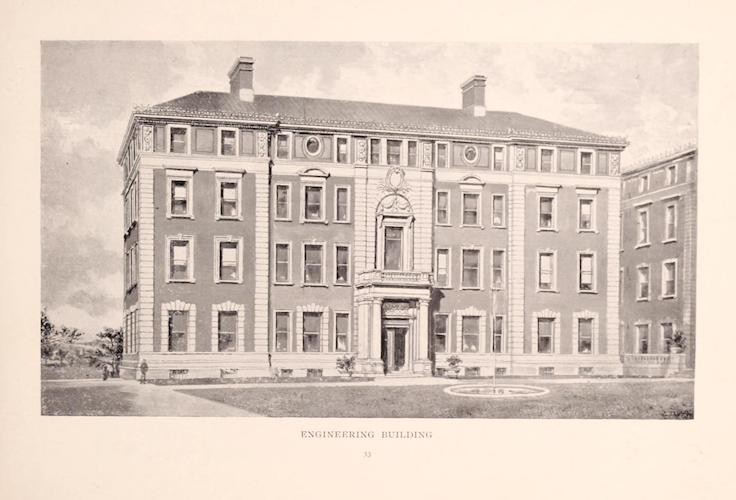
![The sun. (New York [N.Y.]) 1833-1916, November 25, 1908, Page 2 Image of newspaper article entitled: "Wireless Club at Columbia"](/sites/default/files/styles/cu_crop/public/content/image_681x648_from_2064%2C1080_to_3239%2C2199.jpg?itok=YaE5aQX-)

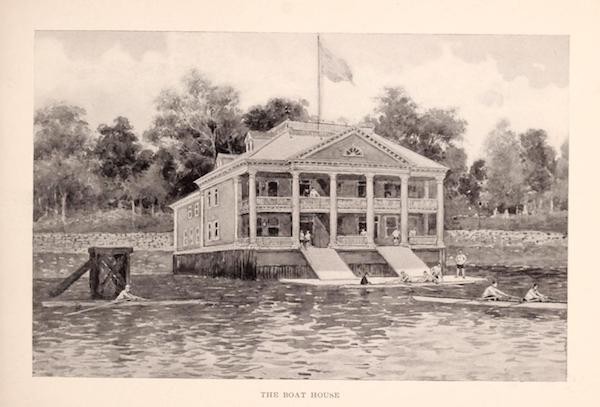
![The Sun. (New York [N.Y.]) 1833-1916, January 30, 1914, Page 3 Newspaper article image](/sites/default/files/styles/cu_crop/public/content/image_681x648_from_1858%2C1172_to_3033%2C2291.jpg?itok=bqdORSLm)
